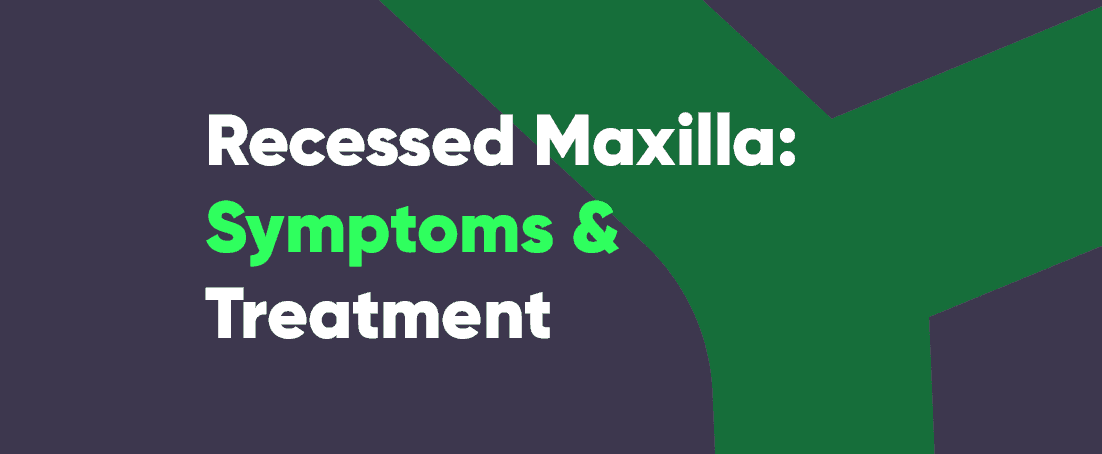
Many people inadvertently adopt improper habits like mouth breathing and incorrect tongue posture from early childhood. These behaviors often go unnoticed, yet their impact on facial structure and overall health is significant. Among the more severe consequences is the development of recessed maxilla symptoms.
A recessed upper jawbone not only compromises your facial aesthetics but can also lead to dental problems or speech issues. I will cover here everything you need to know to understand and treat recessed maxilla symptoms.
What Is a Maxilla Bone?
The maxilla bone is a critical part of your face. it is the upper jawbone that sits right below your nose and above your mouth. This bone holds your upper teeth in place and forms the base for your nasal cavity.
It functions as a structural framework that shapes your face both aesthetically and functionally. Any deformities to the maxilla bone are not only displeasing visually but make even simple tasks, such as eating or speaking, more difficult.
What is a Recessed Maxilla?
A recessed maxilla is a condition where the upper jawbone is set back, rather than aligning properly with the lower jaw. This misalignment can lead to several health problems, including breathing difficulties and sleep apnea.
A recessed maxilla also affects facial aesthetics, often making the face appear less attractive. Unlike a well-positioned maxilla, which supports the face to look balanced, a recessed maxilla tends to make the mid-face look flat or sunken.
Are There Health Risks In Having a Recessed Maxilla?
There many are health risks associated with the recessed maxilla. They range from severe health complications to mild aesthetic issues. Regardless of the severity, all these symptoms warrant attention and treatment.
| Consequence | Description | Severity Evaluation | Cause |
|---|---|---|---|
| Breathing Difficulties | Shallow breaths or gasping for air, especially during sleep | Severe | Misalignment of the jaw affecting the airway |
| Speech Problems | Difficulty in pronouncing words clearly | Moderate | Inadequate space in the oral cavity |
| Self-esteem Concerns | Psychological distress due to facial appearance | Mild to Moderate | Aesthetic issues stemming from jaw misalignment |
| Sleep Apnea | Intermittent pauses in breathing while sleeping | Severe | Restricted airway space due to jaw position |
| Temporomandibular Joint Disorder (TMJ) | Pain or discomfort in the jaw joint | Moderate | Jaw misalignment puts stress on the joint |
| Difficulty Eating | Problems with chewing or swallowing food | Moderate | Altered oral cavity structure |
| Facial Asymmetry | Uneven appearance of the face | Mild to Moderate | Imbalanced jaw structure |
| Dental Issues | Crooked teeth or jaw misalignment leading to oral health problems | Moderate | Altered structure of the maxilla affecting teeth alignment |
| Snoring | Loud noises during sleep affect the quality of sleep | Mild | Partial obstruction of the airway |
| Sinus Problems | Frequent sinus infections or congestion | Moderate | Impaired nasal cavity due to jaw position |
Can a Recessed Maxilla Be Treated?
Yes, the recessed maxilla is a treatable condition. The methods range from orthodontic interventions to surgical procedures, as well as non-invasive techniques like mewing exercises and facial yoga.
These treatments are possible because our bones and facial muscles are not static and respond to various stimuli. The maxilla bone, like other bones in the body, undergoes a process called remodeling. This process involves the breakdown of old bone tissue and the formation of new bone tissue.
Remodeling allows the bone to adapt to new conditions, whether they arise from natural growth, lifestyle changes, or medical interventions. Muscles and soft tissues surrounding the maxilla also play a significant role.
By engaging these muscles through exercises like mewing and facial yoga, you encourage better posture and alignment. These exercises can provide slight but meaningful changes over time, especially when combined with other treatments.
For more severe cases, surgical procedures like Le Fort osteotomy can reposition the maxilla bone, providing immediate and significant improvements.
Perfect Combination of Treatment and Desire to be Attractive: Mewing
Mewing is an exceptional option for treating a recessed maxilla. It’s non-invasive, free of charge, and doesn’t require specialized equipment. All you need is a disciplined approach to consistently practice mewing exercises.
Mewing for maxilla goes beyond the standard practice. While ordinary mewing focuses on optimal tongue posture to improve facial appearance, mewing for a recessed maxilla aims to restructure and bring forward the upper jaw. This targeted approach requires a nuanced understanding of tongue placements and pressures.
Mastering the correct technique demands focus and persistence. This is where a dedicated app like Mewing.coach comes into play. It offers a structured plan tailored to your needs. With scheduled reminders and an array of features to track your progress, Mewing.coach makes it easier to commit to your mewing journey.
Recessed Maxilla Braces
Braces are a common orthodontic solution that works by applying continuous pressure on the teeth and the maxilla. Over time, this pressure helps move the maxilla into a more desirable position.
However, braces are a long-term commitment that often comes with discomfort and high costs. Mewing, on the other hand, is free and can be integrated easily into your daily routine. It serves as a natural first step before opting for braces.
Orthodontic Headgear
Orthodontic headgear is an external appliance that exerts extraoral force to expedite the treatment process. While effective, headgear is cumbersome and can be uncomfortable to wear for extended periods.
Dermal Fillers
Dermal fillers are injectable substances used to alter the facial structure temporarily. They can fill in the areas where the maxilla has receded, providing an immediate but short-lived change.
However, fillers don’t address the root cause of the problem, while practices like Mewing aim to naturally improve the bone structure over time, offering a more permanent solution.
Surgery
Surgical interventions like Le Fort osteotomy provide immediate and significant improvements to the position of the maxilla. These procedures, though highly effective, come with risks such as infection, high costs, and a lengthy recovery period. Mewing poses none of these risks and serves as a non-invasive method to improve maxilla positioning over time.
Recessed Maxilla vs Normal: What’s The Differences
A normal maxilla aligns well with the other facial bones, providing a strong foundation for the upper teeth. It supports the optimal function of the mouth, nose, and even the airways. Breathing is unobstructed, and speech is clear.
In contrast, a recessed maxilla is set back, creating a misalignment that affects not only the teeth but also the overall facial structure. a recessed maxilla can lead to a range of problems from breathing difficulties to speech issues.
Aesthetically, a well-positioned maxilla contributes to a balanced and attractive face. The eyes, nose, and mouth appear in harmonious proportion. A recessed maxilla disrupts this balance. It can make the midface appear unnaturally sunken.
Mewing offers a way to gradually move towards a more normal maxilla alignment. By naturally stimulating bone remodeling through proper tongue posture, you can make incremental but impactful changes.
How Do You Know If You Are Recessed?
Common signs include difficulty breathing through the nose, chronic mouth breathing, or a visibly receding upper jaw. Some people also experience speech difficulties or have less-defined cheekbones and a flatter midface.
The most common method to test if you have a Recessed Maxilla is to make a functional test. If you breathe and speak with difficulty, it might mean you have some form of Recessed Maxilla. It can also appear as an overbite or an underbite, so checking your bite is also an option.
If you visit a healthcare service provider, he may not only examine your face and oral cavity visually but will also use X-rays or 3D scans to view the structure of your bones. However, most of the time, this isn’t necessary, and you can know whether your Maxilla is Recessed from more evident symptoms.
Symptoms of a Recessed Maxilla
Overbites
An overbite often signals a recessed maxilla. The upper jaw’s backward positioning makes the upper teeth appear more prominent than the lower teeth. Those with an overbite may notice difficulty in closing their lips comfortably and may experience wear and tear on their front teeth more quickly.
This symptom might not necessarily be connected to Recessed Maxilla, so mewing for overbite is extremely effective against it.
Underbites
Unlike an overbite, an underbite may occur when the lower jaw is more prominent, but it can also be the result of a recessed maxilla. This misalignment can lead to issues with eating and speaking, making early underbite exercises essential.
Crowded Teeth
A recessed maxilla reduces the amount of space available for teeth to align naturally. Crowded teeth are often a direct consequence, leading to oral hygiene challenges such as increased risk of cavities and gum disease. Can mewing fix crossbite? Yes, but there are some things you should research first.
Speech Difficulties
Poor maxillary alignment can significantly affect speech. A recessed maxilla may result in many articulation issues, as the tongue struggles to make precise contact with the palate and teeth for clear speech. Dysarthria is one of the most common speech disorders, it is caused by muscle weakness or poor coordination in the muscles used for speaking. Mewing is one of the dysarthria treatment approaches.
Changes in Facial Aesthetics
A recessed maxilla often leads to a flatter facial profile, less-defined cheekbones, and sometimes a double chin. Such aesthetic changes may lower self-esteem, underscoring the need for timely intervention like mewing.
What Can Cause a Recessed Maxilla?
Understanding the causes of a recessed maxilla is crucial for prevention and early intervention. Even if you don’t suffer from this condition, gaining insight into its causes is beneficial for general health awareness and could be valuable information for someone you know.
Genetic Factors
Genetics plays a significant role in the development of a recessed maxilla. Certain genes dictate the growth and structure of facial bones. If these genes are not optimally expressed, it could lead to an underdeveloped maxilla.
Poor Oral Habits
Behaviors like thumb-sucking and mouth breathing can significantly affect maxilla development, especially in young children. These habits exert unnatural pressure on the maxilla, potentially causing it to grow in a recessed position over time.
Angelman Syndrome
Angelman Syndrome is a genetic disorder characterized by intellectual and developmental delays. One of its lesser-known effects is its impact on facial bone structure, including a tendency for a recessed maxilla.
Fetal Alcohol Syndrome
Exposure to alcohol during fetal development can result in Fetal Alcohol Syndrome, a condition that often affects facial development. One of the common facial features affected is the maxilla, which can grow in a recessed manner.
Facial Trauma During Childhood
Injuries to the face during formative years can disrupt the normal growth of the maxilla. Falls, accidents, or any trauma that exerts force on the facial area can lead to a recessed maxilla later in life.
Frequently Asked Questions
Is a recessed maxilla a common issue?
A recessed maxilla is a fairly common issue, often overlooked until it starts causing noticeable health or aesthetic problems. Its prevalence highlights the need for greater awareness and early intervention strategies like mewing.
Is forward-grown maxilla better than recessed?
A forward-grown maxilla is generally considered better than a recessed one, both for aesthetic harmony and functional efficiency. It promotes better facial structure, unobstructed breathing, and clearer speech.
Is a recessed maxilla related to sleep apnea?
A recessed maxilla is often associated with sleep apnea, as it can result in a narrower airway, making breathing more difficult during sleep. Addressing this issue through treatments like mewing may alleviate sleep apnea symptoms.
At what age is it best to address a recessed maxilla?
The best age to address a recessed maxilla is during childhood or adolescence when the bones are still growing and more responsive to treatment. However, treatments like mewing can still offer benefits at any age, though changes might occur more gradually in adults.




